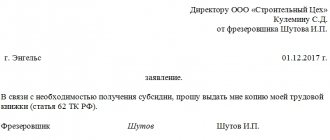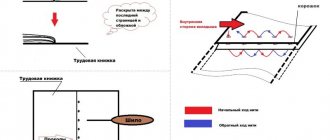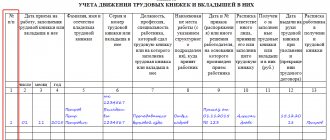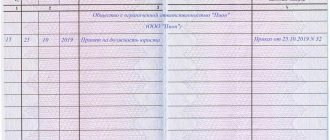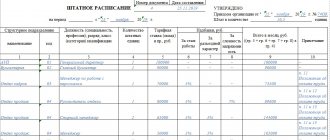What it is
Employment history
– a mandatory personnel records document containing information about the employee’s work activity and length of service. All employers, both organizations (regardless of their legal form) and individual entrepreneurs, are required to maintain them. An exception is made only for employers who are individuals (not registered as individual entrepreneurs).
Work books must be prepared for each employee if he works for more than 5 days and this work is his main job. For an employee hired for the first time, a work book is opened no later than 7 days from the date of employment.
All basic information about the employee, the work he performs, transfers to other positions, incentives and dismissals are entered into the work book. Information about penalties imposed on the employee (reprimand, warning, fine) is not entered in the book.
Categories
In the article, using an example, the author will talk about the procedure for registering a work book for an employee entering work for the first time, as well as on the basis of what documents and how the employer should keep records of work books and write off damaged work book forms (inserts in the work book).
The employer's obligation to prepare a work book
The work book is the main document about the employee’s work activity and length of service.
Work book forms and forms of inserts in work books are documents of strict accountability. An employer (with the exception of individual employers) is obliged to keep a work book for each employee who has worked in an organization for more than five days, if the work in this organization is the main one for the employee (Article 66 of the Labor Code of the Russian Federation).
When concluding an employment contract, a person applying for a job in a particular position (by profession) presents the employer with a work record book, except in cases of being hired part-time or when an employee enters work under an employment contract for the first time (Part 1 of Article 65 of the Labor Code of the Russian Federation) .
Regulatory and methodological documents regulating the preparation and write-off of strict reporting forms
1. Order of the Ministry of Finance of Russia dated December 22, 2003 No. 117n “On work books (together with the Procedure for providing employers with work book forms and an insert in the work book).
2. Decree of the Government of the Russian Federation dated April 16, 2003 No. 225 (as amended on May 19, 2008) “On work books” (together with the Rules for maintaining and storing work books, producing work book forms and providing them to employers).
3. Instructions for filling out work books (approved by Decree of the Ministry of Labor of Russia dated October 10, 2003 No. 69).
4. Letter of the Ministry of Health and Social Development of Russia dated August 30, 2006 No. 5140-17 “On the procedure for maintaining work books by individual entrepreneurs after the Federal Law of June 30, 2006 No. 90-FZ came into force.”
Articles of the Labor Code of the Russian Federation regulating the execution and write-off of strict reporting forms
| Article | Article title |
| 65 | Documents presented when concluding an employment contract |
| 66 | Employment history |
| 84.1 | General procedure for registering termination of an employment contract |
| 234 | The employer's obligation to compensate the employee for material damage caused as a result of illegal deprivation of his opportunity to work |
| 309 | Documents confirming the period of work with employers - individuals |
Registration of a work book for an employee entering work for the first time
In accordance with Part 5 of Art. 65 of the Labor Code of the Russian Federation, Rules for maintaining and storing work books, producing work book forms and providing them to employers (approved by Decree of the Government of the Russian Federation dated April 16, 2003 No. 225; hereinafter referred to as the Rules for maintaining and storing work books) and Instructions for filling out work books (approved by Decree of the Ministry of Labor Russia dated October 10, 2003 No. 69) for employees hired for the first time, the employer must issue a work book.
On August 12, 2009, Selena LLC hired I. B. Arutyunov as an adjuster of 3rd category CNC machines. Arutyunov I.B. goes to work for the first time after graduating from an educational institution, and he does not have a work book. Registration of a work book for an employee hired for the first time is carried out in the presence of the employee no later than a week from the date of hiring. The HR employee draws up a work book based on the submitted documents (originals) - passport and education document.
When drawing up a work book (as well as an insert into it), the employer charges the employee a fee, the amount of which is determined by the amount of expenses for purchasing the forms. Payment is made through the organization's cash desk, or the cost of the form is deducted from the employee's salary. Deduction of the cost of the form from the employee’s salary is possible only upon his written application. A record of the issue of a work book (or an insert in the work book) to the employee is made in the receipt and expenditure book for recording the work book forms and the insert in it, and thus the strict reporting form is written off.
Accounting for work book forms and inserts in it at the enterprise
Accounting for the receipt, expenditure and movement of work books and inserts in them is carried out by each employer.
Until recently, individual entrepreneurs did not have the right to keep work books of employees, but since October 6, 2006, Article 309 of the Labor Code of the Russian Federation assigned this obligation to them.
In order to keep track of work books, as well as work book forms and inserts therein, employers must keep:
1) a receipt and expenditure book for recording the forms of the work book and the insert in it;
2) a book for recording the movement of work books and inserts in them.
The forms of these books are given in Appendices No. 2 and 3 to the Instructions for filling out work books.
the receipt and expenditure book for recording the forms of the work book and the insert in it . Responsibility for maintaining, storing, recording and issuing work books lies with a specially authorized person appointed by order of the employer (example 1). The forms of the work book and its insert are stored in the accounting department as strict reporting documents and are issued to the person responsible for maintaining work books upon his request. The employer is obliged to constantly have in stock the required number of work book forms and the insert in it.
In the book of accounting for the movement of work books and inserts in them , which is maintained by the personnel service, all work books accepted from employees upon entry to work are registered, as well as work books and inserts in them issued to employees, indicating the series and number of the form. Upon dismissal, the employee signs in the book for recording the movement of work books and inserts in them that the work book has been received in his hands (clause 41 of the Rules for maintaining and storing work books).
If on the day of dismissal of an employee (termination of an employment contract) it is impossible to issue a work book due to the absence of the employee or his refusal to receive the work book in hand, the personnel officer draws up an act of refusal to receive the work book by the employee and sends the employee a valuable letter (with a list of attachments and notification about delivery) about the need to appear for a work book or give your consent to send it by mail (clause 36 of the Rules for maintaining and storing work books and Article 84.1 of the Labor Code of the Russian Federation). From the date of sending such a notification, the employer is released from liability for late issuance of a work book (examples 2–4).
Writing off damaged work record forms
Forms of work books and inserts in them that are damaged when filling out are subject to destruction and the corresponding act is drawn up (example 5).
In case of incorrect initial filling of the work book or the insert in it, as well as in case of damage through no fault of the employee, the cost of the damaged form is paid by the employer (clause 48 of the Rules for maintaining and storing work books).
Let's sum it up
1. Work books and inserts in them must be purchased by the employer.
2. The enterprise must maintain strict records and correctly write off work book forms, since these are strict reporting forms.
3. If a work book is issued for the first time, the cost of the form will be charged to the employee.
4. If the form was damaged when completed by an employee of the personnel service, then it is written off at the expense of the employer.
Electronic format of the work book
Note! In 2021, the transition to electronic work books began. All working citizens can choose the format independently.
In accordance with the law of December 16, 2019 No. 439-FZ, by the end of 2020, each employee had to submit an application on how to keep his work book - paper or electronic. If the first option is chosen or the application was not submitted for some reason, then in 2021 a paper TC will be filled out. However, the right to choose remains with the employee. If he writes an application to switch to an electronic format of the work book, the employer will stop keeping it in paper form.
The Ministry of Labor explained the procedure for switching to electronic labor codes in a letter dated August 12, 2020 No. 14-2/OOG-12933. Each employer had to notify its employees about the possibility of switching to an electronic version of the document by October 31, 2021. If the employee chooses the second option, a paper Labor Code is issued to him. Before this, a record is made in it that the employee submitted to the employer an application for the transition to an electronic format of the work book.
Then information about work activity, including the fact of filing an application for the transition to an electronic labor code, is sent to the Pension Fund of the Russian Federation as part of the SZV-TD form. Deadline - no later than the 15th day of the month following the one in which the employee wrote an application to change the format of the book.
After switching to an electronic TC, the employee will no longer be able to return to maintaining it on paper.
Correspondence of series and numbers of work books by year of issue for old samples
| Series of work books (LC) | Year of production TC |
| AT-1 | From 1974 to 1976 |
| AT-2 | From 1977 to 1979 |
| AT-3 | From 1980 to 1982 |
| AT-4 | From 1983 to 1985 |
| AT-5 | From 1990 to 1992 |
| AT-6 | From 1990 to 1992 |
| AT-7 | From 1993 to 1997 |
| AT-8 | From 1998 to 2000 |
| AT-9 | From 2001 to 2003 |
| New shopping malls | 2004 |
Introduction of new TKO forms The main documents stating the regulations of the new type of TK, defining the principles of filling them out and working with them on the basis of new forms of management are:
- Resolution of the PRF dated April 16, 2003 No. 225, which includes Rules for working with new types of technical equipment.
- Resolution of the Ministry of Labor dated October 10, 2003 No. 69, containing Instructions for working with new labor standards.
The need to introduce new forms of forms has become ripe due to the fact that the Russian legal system has become stronger and has introduced new forms of recording labor activity, based on the provisions of the Labor Code of the Russian Federation and fundamentally new forms of management, radically different from the Soviet ones.
However, a decision was made to keep in use all accounting documents through which the labor activities of citizens are carried out and monitored.
Requirements for filling out a work book
When filling out a work book, you must take into account the following requirements:
- filling language – Russian;
- dates are indicated in Arabic numerals (for example, 01/01/2003);
- information must be entered carefully using a fountain or gel pen, a rollerball pen (including a ballpoint pen), or light-resistant ink (paste, gel) in black, blue or purple;
- no abbreviations are allowed (for example, pr. instead of “order”, disp. instead of “instruction”, etc.);
- It is not allowed to cross out previously made inaccurate, incorrect or other invalid entries in the sections “Information about work” and “Information about awards”;
Note: if such an error is made, it is corrected by making an entry under the next number in the format “The entry behind number such and such is invalid” and then, on the next line, the correct entry is indicated with duplication of the number and date of the order.
- the employee must be familiarized with all entries made in the work book against signature on a personal card, which also duplicates all the information;
- The work book also contains information about military service, training, advanced training and retraining;
- entries about bonuses paid monthly are not included in the work book.
Features of filling out a work book
When filling out a work book, it is important to consider the following features:
- Filling out the book begins with column 3, in which you must indicate the full and abbreviated name of the organization. Instead, it is permissible to put a stamp indicating the name. If an employee is hired by a branch, the name of the parent organization is indicated.
- After column 3, column 1 is filled in, which indicates the serial number of the entry. When making an entry, the order of continuous numbering must be observed. That is, if the previous entry was number 8, the next one will be number 9.
- In column 2, you must indicate the start date of work in accordance with the order.
- In column 3 (opposite the start date of work) it is necessary to indicate the position, specialty or profession, indicating the qualifications for which the employee was hired and the name of the department in which he will work.
- Column 4 indicates the date and number of the employment order.
